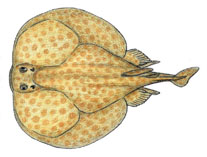Upload your photos and videos
Pictures | Google imageTorpedo andersoni
Picture by Simpson, R.
Pictures | Google imageTorpedo andersoni
Picture by Simpson, R.
Classification / Names Κοινά ονόματα | Συνώνυμα | Catalog of Fishes(Γένος, Είδη) | ITIS | CoL | WoRMS | Cloffa
Ελασμοβράγχιοι (καρχαρίες και σαλάχια) (sharks and rays) > Torpediniformes (Electric rays) > Torpedinidae (Electric rays)
Etymology: Torpedo: Latin, torpere = be sluggish (Ref. 45335).
Eponymy: William Wyatt Anderson (1909–1993) was an American ichthyologist who was a Fisheries Research Biologist at the State Game and Fish Commission, Coastal Fisheries Division, Brunswick, Georgia, USA, and a close friend of the describer. [...] (Ref. 128868), visit book page.
Etymology: Torpedo: Latin, torpere = be sluggish (Ref. 45335).
Eponymy: William Wyatt Anderson (1909–1993) was an American ichthyologist who was a Fisheries Research Biologist at the State Game and Fish Commission, Coastal Fisheries Division, Brunswick, Georgia, USA, and a close friend of the describer. [...] (Ref. 128868), visit book page.
Environment: milieu / climate zone / depth range / distribution range Οικολογία
Θαλασσινό(ά) βενθικό(ς); εύρος βάθους ? - 229 m (Ref. 58018). Subtropical; 26°N - 17°N, 83°W - 76°W (Ref. 114953)
Κατανομή Χώρες | Περιοχές FAO | Οικοσυστήματα | Παρουσίες | Point map | Εισαγωγές | Faunafri
Western Central Atlantic: along the western edge of the Great Bahama Bank, Florida Straits and off Nicaragua.
Μέγεθος / Βάρος / Age
Found inshore to 10 m depth in coral-reef habitats (Ref. 114953). Ovoviviparous (Ref. 50449). Smallest specimens at ca. 15 cm TL (Ref. 114953).
Life cycle and mating behavior Γεννητική Ωρίμανση | Αναπαραγωγή | Γεννοβολία | Αβγά | Γονιμότητα | Προνύμφες
Exhibit ovoviparity (aplacental viviparity), with embryos feeding initially on yolk, then receiving additional nourishment from the mother by indirect absorption of uterine fluid enriched with mucus, fat or protein through specialised structures (Ref. 50449).
Main reference
Upload your references | Αναφορές | Συντονιστής : Carvalho, Marcelo | Συνεργάτες
Eschmeyer, W.N. (ed.), 1998. Catalog of fishes. Special Publication, California Academy of Sciences, San Francisco. 3 vols. 2905 p. (Ref. 26282)
CITES
Not Evaluated
Threat to humans
Harmless
Human uses
FAO - Publication: search | FishSource |
Περισσότερες πληροφορίες
Trophic ecology
Τροφικά αντικείμενα
Σύσταση δίαιτας
Κατανάλωση τροφής
Food rations
Θηρευτές
Τροφικά αντικείμενα
Σύσταση δίαιτας
Κατανάλωση τροφής
Food rations
Θηρευτές
Ecology
Οικολογία
Οικολογία
Population dynamics
Παράμετροι Αύξησης
Max. ages / sizes
Length-weight rel.
Length-length rel.
Length-frequencies
Mass conversion
Στρατολόγηση
Αφθονία
Παράμετροι Αύξησης
Max. ages / sizes
Length-weight rel.
Length-length rel.
Length-frequencies
Mass conversion
Στρατολόγηση
Αφθονία
Life cycle
Αναπαραγωγή
Γεννητική Ωρίμανση
Maturity/Gills rel.
Γονιμότητα
Γεννοβολία
Spawning aggregations
Αβγά
Egg development
Προνύμφες
Δυναμική προνυμφών
Αναπαραγωγή
Γεννητική Ωρίμανση
Maturity/Gills rel.
Γονιμότητα
Γεννοβολία
Spawning aggregations
Αβγά
Egg development
Προνύμφες
Δυναμική προνυμφών
Anatomy
Επιφάνεια βραγχίων
Brain
Otolith
Επιφάνεια βραγχίων
Brain
Otolith
Physiology
Body composition
Nutrients
Κατανάλωση οξυγόνου
Κολυμβητικός τύπος
Ταχύτητα κολύμβησης
Visual pigments
Fish sound
Diseases & Parasites
Toxicity (LC50s)
Body composition
Nutrients
Κατανάλωση οξυγόνου
Κολυμβητικός τύπος
Ταχύτητα κολύμβησης
Visual pigments
Fish sound
Diseases & Parasites
Toxicity (LC50s)
Genetics
Γενετική
Heterozygosity
Κληρονομικότητα
Γενετική
Heterozygosity
Κληρονομικότητα
Human related
Aquaculture systems
Προφίλ υδατοκαλλιεργειών
Στελέχοι
Ciguatera cases
Stamps, coins, misc.
Aquaculture systems
Προφίλ υδατοκαλλιεργειών
Στελέχοι
Ciguatera cases
Stamps, coins, misc.
Εργαλεία
E-book | Οδηγός πεδίου | Κλείδες προσδιορισμού | Ανάλυση κατά μήκος συνθέσεων | Εργαλείο ιστορίας ζωής | Σημειακός χάρτης | Classification Tree
| Catch-MSY |
Special reports
Download XML
Διαδικτυακές πηγές
AFORO (otoliths) | Aquatic Commons | BHL | Cloffa | BOLDSystems | Websites from users | Check FishWatcher | CISTI | Catalog of Fishes: Γένος, Είδη | DiscoverLife | ECOTOX | FAO - Publication: search | Faunafri | Fishipedia | Fishtrace | GenBank: genome, nucleotide | GloBI | Google Books | Google Scholar | Google | IGFA World Record | MitoFish | Otolith Atlas of Taiwan Fishes | PubMed | Reef Life Survey | Socotra Atlas | Δέντρο Ζωής | Wikipedia: Go, αναζήτηση | World Records Freshwater Fishing | Zoobank | Zoological Record
Estimates based on models
Phylogenetic diversity index (Ref. 82804): PD50 = 0.5005 [Uniqueness, from 0.5 = low to 2.0 = high].
Bayesian length-weight: a=0.01479 (0.00665 - 0.03288), b=2.96 (2.77 - 3.15), in cm total length, based on LWR estimates for this (Sub)family-body shape (Ref. 93245).
Τροφικό Επίπεδο (Ref. 69278): 4.0 ±0.7 se; based on size and trophs of closest relatives
Ελαστικότητα (Ref. 120179): Χαμηλό, ελάχιστος χρόνος για διπλασιασμό πληθυσμού 4,5 - 14 έτη (Live nearer with low fecundity (RF)).
Fishing Vulnerability (Ref. 59153): Low vulnerability (12 of 100).




